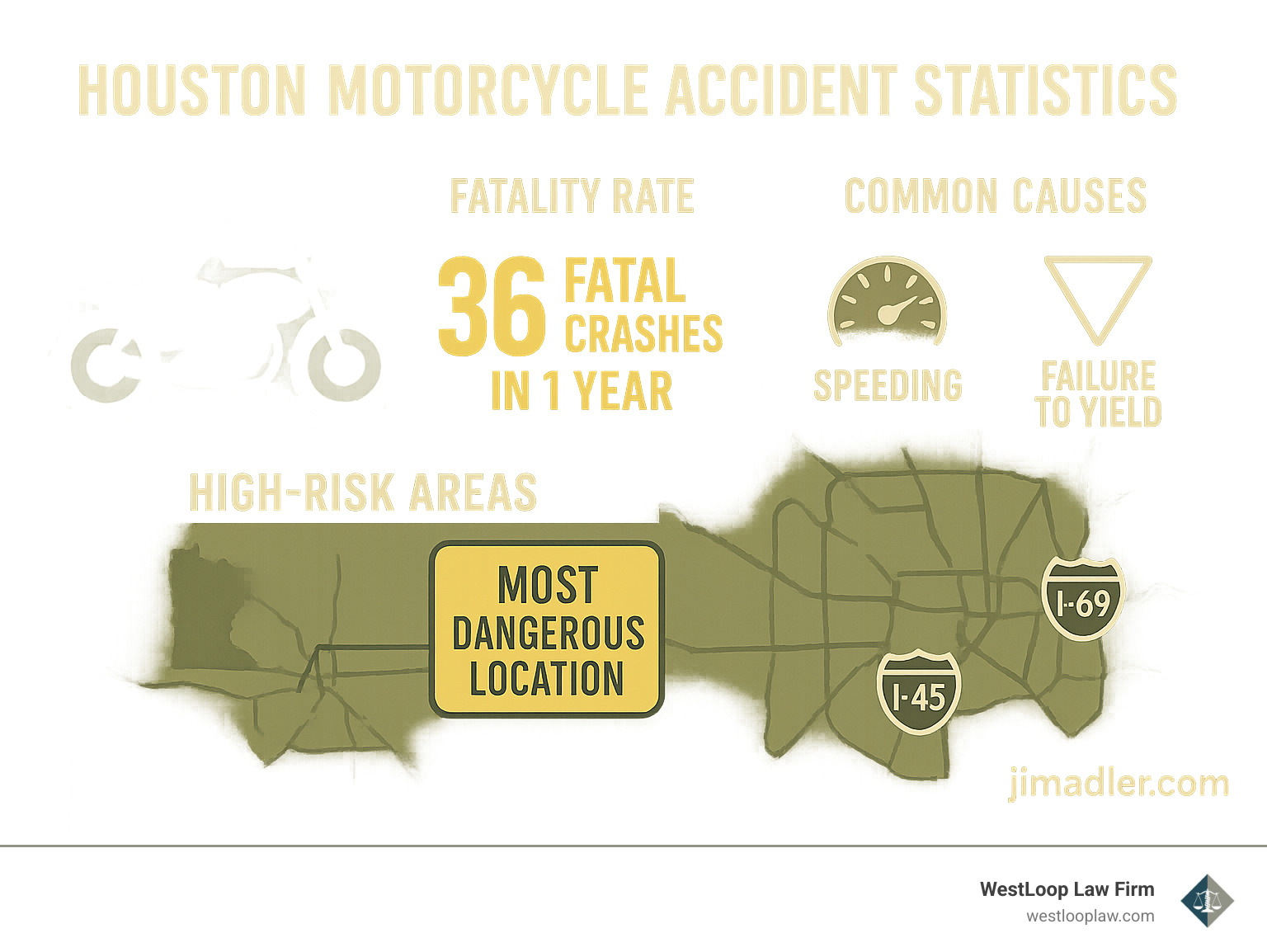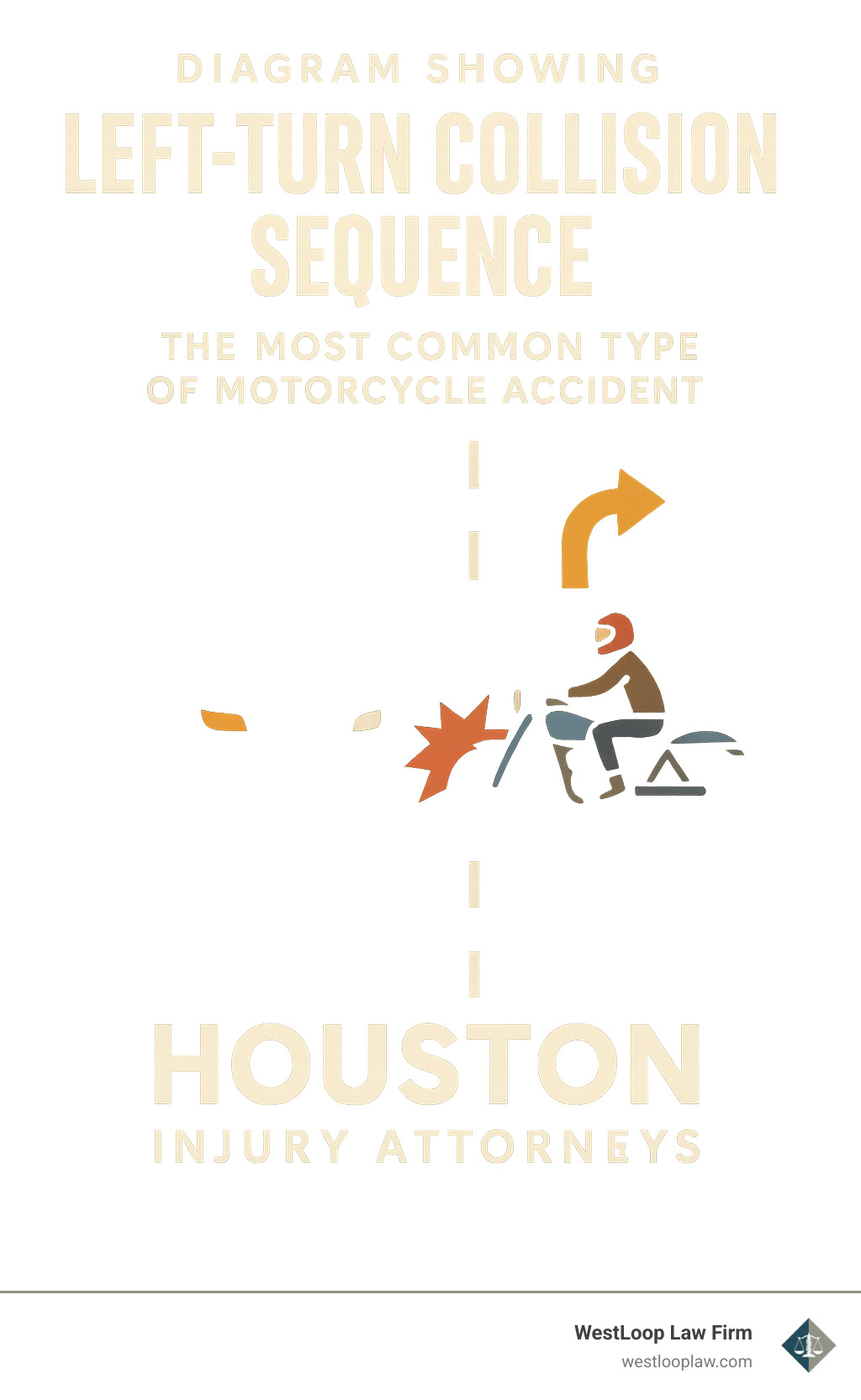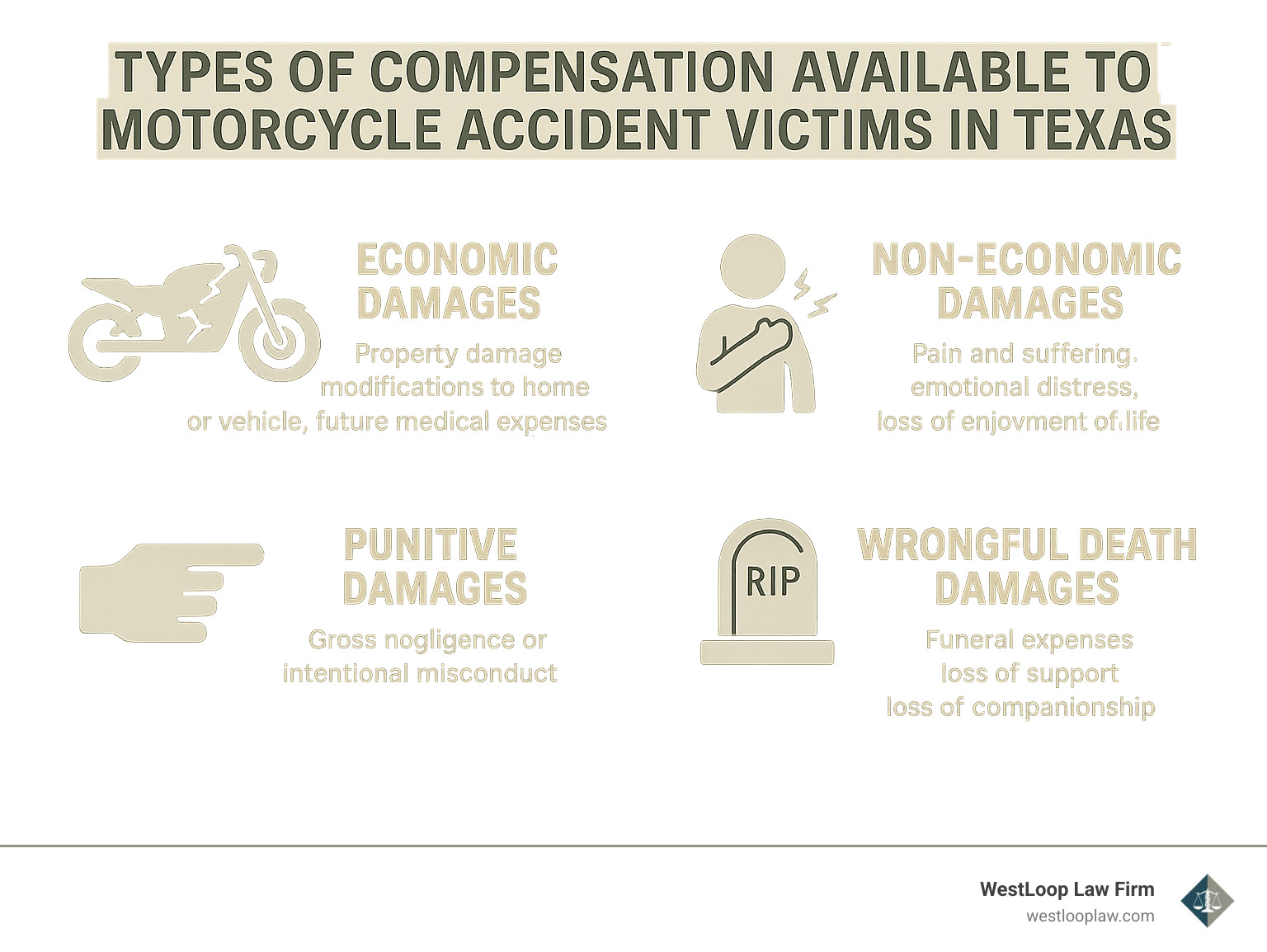The Rising Dangers on Houston’s Roadways
Houston motorcycle accidents are increasing at an alarming rate, creating a crisis for riders across Harris County. If you’re seeking information about motorcycle crashes in Houston, here’s what you need to know:
- Frequency: 671 motorcycle crashes occurred within Houston city limits in the most recent reporting year
- Severity: 85% of Houston motorcycle crashes result in at least a “possible” injury
- Fatalities: 36 fatal motorcycle accidents occurred in Houston in that period
- Proportion: Motorcycles account for under 2% of vehicles but 14% of fatal crashes in Houston
- Risk: Motorcycle riders are 35 times more likely to die in crashes than car occupants
The statistics paint a sobering picture. While motorcycles offer the thrill of the open road and convenient transportation, riding in Houston comes with significant risks.
“Houston has a less-than-stellar reputation among motorcyclists,” notes a recent safety report, with dangerous traffic conditions and frequent wrecks prompting concern among riders and safety advocates alike.
Despite comprising fewer than 2% of registered vehicles in Texas, motorcycles are involved in 14% of fatal traffic crashes and 11% of serious injury accidents in Houston. This disproportionate risk highlights the vulnerability of motorcyclists on Houston’s busy highways and streets.
The human toll behind these numbers is devastating. Families lose loved ones, riders suffer life-altering injuries, and the financial burden of medical bills and lost wages can be overwhelming.
Harris County consistently ranks as the most dangerous area for motorcyclists in Texas, with 6,157 motorcycle accidents per year among its 4.4 million residents. The combination of heavy traffic, distracted drivers, and complex highway interchanges creates a perfect storm of danger for Houston’s motorcycle community.
Why This Guide Matters
Understanding the risks of riding in Houston isn’t just about statistics—it’s about saving lives. With proper awareness of local danger zones, common crash causes, and legal rights, riders can better protect themselves both on the road and after an accident occurs.
This guide compiles the latest data from the Texas Department of Transportation’s Crash Records Information System (CRIS), along with insights from safety experts and legal professionals who handle houston motorcycle accident cases daily. Our goal is to provide practical information that helps riders make informed decisions.
Who Should Read
This guide is essential reading for:
- Active motorcyclists navigating Houston’s complex highway system
- New riders considering taking to Houston’s roads
- Passengers who ride on motorcycles in the Houston area
- Family members concerned about loved ones who ride
- Daily commuters who share the road with motorcyclists
Even experienced riders benefit from understanding the specific risks that make Houston’s roadways particularly challenging for motorcyclists.
Houston Motorcycle Accidents: Statistics and Trends
Behind every houston motorcycle accident statistic lies a human story—a rider who didn’t make it home, a family forever changed, or someone facing a long road to recovery. The numbers in Houston paint a sobering picture that every rider should understand.
In the most recent reporting year, 671 motorcycle crashes occurred within Houston city limits. These weren’t just fender benders—they were life-altering events. Of these crashes, 36 resulted in fatalities, 130 caused serious injuries, and 185 involved minor injuries. Another 215 were reported as involving “possible injury,” while only 91 resulted in no injuries at all (with 14 having unknown outcomes).
Think about that for a moment: 85% of houston motorcycle accidents resulted in at least a “possible” injury. More than half caused a confirmed injury. These aren’t just statistics—they’re a stark reminder of the vulnerability riders face every time they hit Houston’s roads.
According to the National Highway Traffic Safety Administration (NHTSA), motorcycle riders are 35 times more likely to be killed in an accident than passenger car drivers. This dramatic difference in risk becomes especially concerning in a busy urban environment like Houston.
The statewide picture mirrors these troubling trends. Across Texas, 482 motorcycle riders and passengers lost their lives in a recent year. Perhaps most heartbreaking is that nearly half (49%) of those who died weren’t wearing helmets—a simple safety measure that might have saved their lives.
How Common Are Houston Motorcycle Accidents Statewide?
Harris County consistently leads Texas in the sheer number of motorcycle accidents, but understanding how Houston compares to other major Texas cities provides valuable context:
| City | Annual Motorcycle Crashes | Population | Crashes per 100,000 Residents |
|---|---|---|---|
| Houston (Harris County) | 6,157 | 4,434,257 | 138.8 |
| Dallas County | 3,941 | 2,613,539 | 150.8 |
| San Antonio (Bexar County) | 3,107 | 1,986,049 | 156.4 |
| Austin (Travis County) | 2,317 | 1,226,698 | 188.9 |
| Bell County | 825 | 330,859 | 249.4 |
While Harris County sees the highest total number of motorcycle accidents due to its size, some smaller counties like Bell County actually have higher per-capita accident rates. This suggests motorcycle safety challenges exist throughout Texas, though Houston’s massive size and complex traffic patterns make it the epicenter of motorcycle crashes in the state.
Houston Motorcycle Accidents by the Numbers 2023
More recent data reveals a troubling trend: 733 motorcycle accidents occurred within Houston city limits in 2021, showing an increase from previous years. This translates to approximately one accident per 3,200 residents—a rate that should concern every Houston rider.
Digging deeper into the data reveals several key risk factors. Almost one-third of motorcycle crashes in Texas involve alcohol—a preventable factor that dramatically increases risk. About half of fatal motorcycle accidents involve riders without proper motorcycle license endorsements, highlighting the importance of proper training and certification.
Perhaps most alarming, 44% of all fatal motorcycle accidents in Texas involved alcohol, and 52% of motorcyclists who lost their lives weren’t wearing helmets. These aren’t just numbers—they’re missed opportunities to prevent tragedy.
Understanding these statistics isn’t about creating fear—it’s about fostering awareness. By recognizing the most common risk factors—impaired riding, lack of proper training, and inadequate safety gear—Houston riders can make choices that significantly reduce their chances of becoming another statistic in the city’s motorcycle accident reports.
Danger Zones, Causes, and Prevention
Understanding where and why motorcycle accidents happen in Houston is crucial for prevention. Analysis of crash data reveals several high-risk areas and common accident causes.
Most Dangerous Intersections in Houston
Several locations stand out as particularly hazardous for motorcyclists:
-
I-45/I-69 Interchange: This downtown interchange consistently ranks as the most dangerous location for motorcyclists, with multiple crashes recorded annually.
-
I-610 & Westheimer: This busy intersection sees a high volume of motorcycle crashes, often involving vehicles making left turns across traffic.
-
I-69 & I-610: Another dangerous interchange where multiple fatal motorcycle crashes have occurred.
-
I-45 & I-610: The complex traffic patterns at this interchange create numerous conflict points for motorcyclists.
-
I-610 near North McCarty Street: This stretch of highway has seen numerous motorcycle accidents.
-
I-45 & the Hobby Airport access road: Eleven motorcycle accidents, including one fatality, occurred at this location in a recent year.
-
Shepherd Drive & Memorial Drive: This urban intersection has a high rate of motorcycle crashes.
-
Katy Freeway (I-10) at Fry Road: A recent fatal multi-motorcycle crash at this location highlighted its dangers.
-
FM 1960 & Jones Road: This intersection in northwest Harris County sees frequent motorcycle accidents.
-
Bissonnet Street & Wilcrest Drive: Another urban intersection with a high motorcycle crash rate.
These locations share common characteristics: complex traffic patterns, high volume, multiple turn lanes, and limited visibility. Riders should exercise extreme caution when navigating these areas.
Top Risk Factors You Can Control
While you can’t control other drivers’ behavior, several risk factors are within your power to manage:
1. Helmet Use
Wearing a DOT-approved helmet reduces the risk of death by 40% and the risk of head injury by 70%. Despite these statistics, many Texas riders choose not to wear helmets. Under Texas law, riders under 21 must wear a helmet, while those 21 and older can forego a helmet if they complete a safety course or carry qualifying health insurance. However, failure to wear a helmet when required can limit recovery for head injuries in the event of a crash.
2. Speed Discipline
Speeding was a factor in 130 houston motorcycle accidents in 2021 (17.7% of all crashes). Maintaining appropriate speed for conditions is crucial, as motorcycles require more skill to operate at high speeds than cars.
3. Alcohol Avoidance
With alcohol involved in nearly one-third of Texas motorcycle crashes, adopting a strict no-ride alcohol policy is essential. Even small amounts of alcohol can impair the balance and judgment needed for safe motorcycle operation.
4. Visibility Improvement
Many crashes occur because drivers fail to see motorcycles. Using headlights at all times, wearing bright or reflective clothing, and positioning yourself where you’re most visible in traffic can help prevent these accidents.
5. Rider Training
Formal motorcycle safety training significantly reduces crash risk. Many fatal accidents involve riders without proper license endorsements, suggesting a lack of formal training.
A particularly dangerous scenario for motorcyclists is the left-turn collision. This occurs when a car or truck turns left across the path of an oncoming motorcycle. Research on “inattentional blindness” helps explain why these crashes are so common: drivers may look directly at an approaching motorcycle but fail to register its presence due to its smaller visual profile compared to cars. You can learn more about this phenomenon in the latest research on inattentional blindness.
As one safety report notes, “Almost half of fatal motorcycle accidents involve a passenger car or pickup truck turning into a motorcycle.” This phenomenon highlights the importance of defensive riding and improved visibility.
After the Impact: Medical First Aid, Evidence & Injuries
Those first moments after a motorcycle crash can feel like a blur of pain, confusion, and adrenaline. Yet what you do in these critical minutes can make all the difference—both for your health and your legal rights down the road.
Immediate Checklist After a Houston Motorcycle Accident
When the unthinkable happens and you’re involved in a houston motorcycle accident, taking the right steps can literally save your life and protect your future:
Safety comes first—always. If you can move, get to a safe spot away from traffic. Call 911 right away, even if injuries seem minor. Keep your helmet on until medical professionals arrive; removing it incorrectly could worsen a neck or spine injury you didn’t even know you had.
Document everything while it’s fresh. Snap photos of the crash scene from multiple angles, all vehicles involved, and your visible injuries. The phone in your pocket becomes your most powerful evidence-gathering tool in these moments. Ask bystanders if they saw what happened and jot down their contact info—witnesses often disappear once the scene clears.
Don’t brush off medical attention. Even if you feel “fine,” your body’s shock response might be masking serious injuries. That “just a bruise” could actually be internal bleeding. Get checked out by professionals, and follow every bit of their advice. Those medical records become crucial evidence if you need to file a claim later.
Hold onto everything. That cracked helmet, torn jacket, and damaged bike are powerful physical evidence of your crash. Store them exactly as they are—don’t clean or repair anything until your case resolves. Take clear photos of all damage.
When you notify your insurance company, stick to the basic facts. Avoid giving recorded statements or accepting early settlement offers without talking to a lawyer first. Insurance adjusters work for their company, not for you, and those quick offers rarely cover the full extent of your injuries and losses.
As we explain in our guide on The Crucial Role of Evidence in Motorcycle Accident Claims, “Early investigation secures evidence, witnesses, and counters insurance company efforts.” While you’re recovering, insurance companies are building their case—make sure you’re protecting yours too.
Common Injuries and Recovery Timelines
Motorcycle crashes often result in injuries more severe than typical car accidents. Understanding what you might be facing can help prepare you for the road ahead:
Lower Extremity Injuries are the most common in motorcycle crashes. When bikes go down, they often fall onto riders’ legs, causing fractures from ankle to hip. A simple leg break might heal in 3-6 months, but complex fractures—especially those requiring surgery—can take 6-12 months or longer before you’re back to normal. Many riders find themselves temporarily unable to walk, drive, or work during this time.
Upper Extremity Injuries happen when riders instinctively put out their arms during a fall. Broken collarbones, wrists, and arms typically need 2-3 months to heal for simple fractures, longer if surgery is required. These injuries can make even basic daily tasks like dressing or cooking nearly impossible without help.
Road Rash might sound minor, but it’s actually a painful friction burn that scrapes away layers of skin. Minor cases heal in 2-4 weeks, but severe cases can require skin grafts and leave permanent scarring. Infection is a serious risk, especially in Houston’s warm climate, making proper wound care essential.
Head and Brain Injuries range from mild concussions to life-altering traumatic brain injuries. Even with a helmet (which reduces your risk by about 14%), head injuries remain common in houston motorcycle accidents. Recovery varies dramatically—from weeks for mild concussions to years for severe TBIs, with some effects becoming permanent. These injuries can change not just how you function, but who you are.
Spinal Injuries are among the most devastating motorcycle crash outcomes. From herniated discs to vertebrae fractures or spinal cord damage, these injuries can lead to chronic pain, limited mobility, or even paralysis. Recovery typically takes months to years, with some injuries requiring lifelong adaptation and care.
Psychological Trauma often goes unrecognized but can be just as debilitating as physical injuries. Many riders develop PTSD after serious crashes, experiencing flashbacks, anxiety, or fear that prevents them from riding again or even driving. This invisible injury may require professional counseling and support to overcome.
Even “minor” motorcycle accidents often result in injuries that take months to heal completely. Beyond the physical pain, these injuries create a cascade of financial challenges—mounting medical bills, lost wages during recovery, and sometimes permanent changes to your earning ability.
At WestLoop Law Firm, we’ve seen how these injuries impact riders’ lives, which is why we fight to ensure our clients receive the full compensation they deserve for both immediate and long-term effects of their accidents.
Navigating Claims, Rights, and Compensation
After a houston motorcycle accident, understanding your legal rights isn’t just helpful—it’s essential for getting the compensation you deserve. Texas law offers specific protections for riders, but there are also important limitations you should know about before moving forward with a claim.
How a Houston Motorcycle Accident Lawyer Strengthens Your Case
When you’re healing from injuries, the last thing you need is to battle insurance companies alone. At WestLoop Law Firm, we’ve seen how proper legal representation can transform the outcome of motorcycle accident claims.
A good attorney doesn’t just file paperwork—they become your advocate during one of life’s most challenging moments. We start with a thorough investigation, examining the crash scene, analyzing police reports, and interviewing witnesses who saw what happened. Sometimes we bring in accident reconstruction experts to create a clear picture of exactly how the crash occurred.
Insurance companies often swoop in quickly after motorcycle crashes with tactics designed to minimize what they pay out. They might offer a quick settlement before you even know the full extent of your injuries, try to shift blame onto you as the rider, or question whether your medical treatments were really necessary. Some even use delay tactics, hoping you’ll eventually accept less out of frustration or financial pressure.
Having seen these strategies countless times, we know exactly how to counter them. We also ensure your claim is properly valued—many riders don’t realize their case is worth far more than initial offers suggest. We consider not just your current medical bills, but future expenses, lost wages, reduced earning capacity, and the very real pain and suffering you’ve experienced.
Texas follows what’s called a “51% bar rule” under modified comparative fault. In simple terms, this means you can recover damages as long as you’re not more than 51% responsible for what happened. Your compensation gets reduced by your percentage of fault, and if you’re found 51% or more at fault, you can’t recover damages at all. This system makes skilled representation crucial, as the other side will almost certainly try to push more blame onto you.
While most cases settle outside of court, we prepare every case as if it will go to trial. This thoroughness often leads to better settlement offers, as insurance companies realize we’re serious about fighting for what you deserve.
Compensation Riders Can Pursue Under Texas Law
Texas law allows motorcycle accident victims to seek several types of compensation. Economic damages cover your quantifiable financial losses—medical bills, rehabilitation costs, lost wages, property damage, and even future medical care you might need. These are the bills and expenses you can add up with receipts and documentation.
Non-economic damages address the subjective, harder-to-quantify losses that nonetheless profoundly affect your life. This includes physical pain and suffering, emotional distress, loss of enjoyment of life, and even the impact on your relationships. These damages acknowledge that a serious injury affects far more than just your bank account.
In cases involving truly reckless behavior—like a driver who was extremely intoxicated or texting after multiple previous offenses—punitive damages might be available. These are designed not just to compensate you, but to punish especially bad conduct and deter others from similar behavior.
When the unthinkable happens and a motorcycle accident results in death, surviving family members can pursue wrongful death damages. These can include funeral expenses, lost financial support the deceased would have provided, and compensation for the loss of companionship and guidance.
It’s worth noting that Texas doesn’t cap compensatory damages in most personal injury cases, though there are limits on punitive damages and in medical malpractice cases.
Our work as motorcycle accident attorneys goes far beyond paperwork filing. As explained in our guide on the Role of Motorcycle Accident Attorneys in Houston, we become your investigators, negotiators, advocates, and when necessary, courtroom fighters. Our singular goal is making sure you receive full and fair compensation for everything you’ve lost and suffered because of someone else’s negligence.
Conclusion
Houston motorcycle accidents present unique challenges for riders, their families, and the legal system. The disproportionate risk faced by motorcyclists on Houston’s highways demands heightened awareness, preventive measures, and knowledge of legal rights.
Key takeaways from this guide include:
- Houston and Harris County lead Texas in motorcycle accident frequency
- Certain intersections and highway interchanges present particularly high risks
- Helmets dramatically reduce fatality and injury rates
- Alcohol involvement and lack of proper licensing are major risk factors
- Proper evidence collection immediately after a crash is crucial
- Texas’s comparative fault rules make skilled legal representation essential
At WestLoop Law Firm, we understand the devastating impact that motorcycle accidents can have on victims and their families. Our combined expertise in personal injury and probate law allows us to provide comprehensive representation for all aspects of motorcycle accident claims, including wrongful death cases that may involve probate issues.
We encourage all Houston motorcyclists to ride safely, wear appropriate protective gear, and know their rights in case of an accident. If you or a loved one has been injured in a motorcycle crash, timely legal advice can make a significant difference in the outcome of your case.
For more information about motorcycle accident representation, visit our motorcycle accident page. Our team is ready to provide the guidance and advocacy you need during this challenging time.
Riding a motorcycle in Houston offers freedom and excitement, but it also comes with significant responsibilities and risks. By staying informed, alert, and prepared, you can enjoy the ride while minimizing dangers on Houston’s highways.





